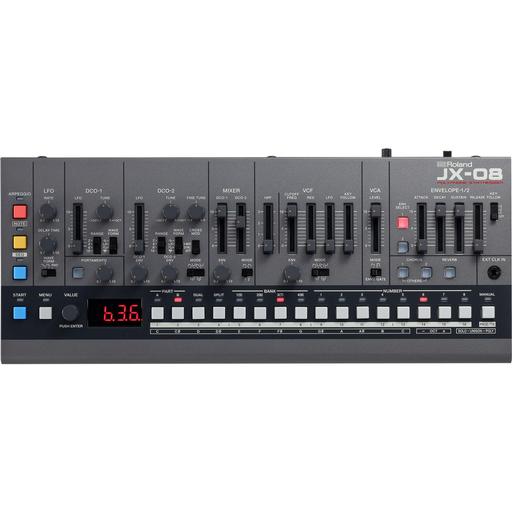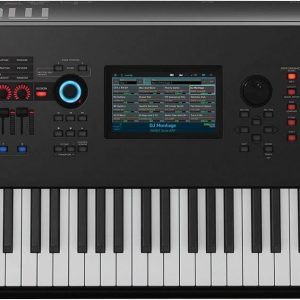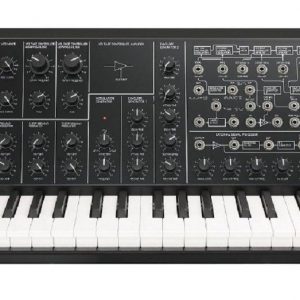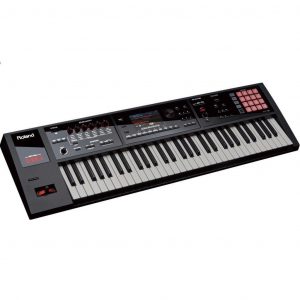Roland JX-08
$268.99
Experience the classic analog sound of the ‘80s with the Roland JX-08, a vintage synth synthesizer that will bring your music to life.
Compare
Description
The Roland JX-08 Synthesizer is a modern-day incarnation of the classic JX-3P synthesizer from the 1980s. Its compact design and sound quality make it a popular choice for musicians and producers alike.
The JX-08 is a 4-voice polyphonic synthesizer that features two digitally controlled oscillators (DCO) per voice, a resonant low-pass filter, and an integrated chorus effect. There are also two envelope generators, one for amplitude and one for filter modulation, and a single LFO for modulation purposes.
One of the standout features of the JX-08 is its ability to create rich, warm pads and strings. The oscillator section includes sawtooth, square, and pulse waveforms, allowing for a wide range of sound possibilities. The chorus effect also contributes to the lush character of these sounds.
In addition to its classic pad and string sounds, the JX-08 can also produce punchy basses and sharp leads. The filter section offers control over resonance and cutoff frequency, allowing for precise sound shaping.
To further expand on the JX-08’s sound capabilities, it also includes a built-in arpeggiator and a sequencer with up to 16 steps. These features make it an excellent choice for electronic music production, especially in genres like synthwave and retrowave.
The JX-08 is also lightweight and compact, making it an ideal choice for musicians who need a portable synthesizer. Its intuitive layout and easy-to-use interface make it a great option for beginners who are just starting with synthesizers.
One minor drawback of the JX-08 is that it does not have a built-in keyboard. Instead, it is meant to be used with an external MIDI controller or sequencer. However, this can also be seen as an advantage for some musicians who prefer to use their own preferred keyboard or controller.
Overall, the Roland JX-08 Synthesizer is a powerful and versatile synthesizer that offers classic analog sounds and modern features. Its compact design and excellent sound quality make it an excellent choice for both home studio and live performances.
Roland JX-08 properties
| Product name |
Roland JX-08 |
| Brand |
Roland |
| Type |
Synthesizers |
| Keys |
No |
| Drawbars/Sliders |
Yes |
| Pads |
No |
| Rotary Controls |
Yes |
| Modulation Wheel |
No |
| Pre-Programmed Rythms |
No |
| Pre-Programmed Songs |
No |
| Pre-Programmed Sounds |
No |
| Pre-Programmed Drumset |
No |
| Pre-Programmed Effects |
Yes |
| Built-In Tuner |
Yes |
| Portable |
Yes |
| Speakers |
Yes |
| Connections |
3.5mm (AUX), Headphone, MIDI, MIDI Through USB, USB |
| Colour |
Black |
| Power Supply |
USB |
Frequently Asked Questions:
What is the unique MIDI control option available on the Roland JX-08 synthesizer for adjusting filter cutoff frequencies?
The unique MIDI control option available on the Roland JX-08 synthesizer for adjusting filter cutoff frequencies is the "Envelope Follow (EF)" option. A0 Envelope Detail will allow you to adjust the filter cutoff frequency using a keyboard or with a drum pad, while A36 Normal Envelope will allow you to use an electronic percussion instrument such as a TR-808 or TR-909 to adjust the filter cutoff frequency.
How can I properly program and utilize the Super Saw oscillator on the Roland JX-08 synthesizer to achieve a thick and powerful bass sound?
To program a thick and powerful bass sound using the Super Saw oscillator on the Roland JX-08 synthesizer, follow these steps:
1. Start by setting your JX-08 to monophonic mode (Press "Mono" button). Next, select "Super Saw" as your oscillator type (Press "OSC" button and select "Super Saw"). Adjust the oscillator pitch to your desired bass frequency. For a powerful low end, set it between C1 and G1. Increase the oscillator's waveform detune amount to thicken up the sound. This can be done by pressing "DETUNE" button and adjusting the value using the "DETUNE" knob. To add some harmonic richness to the sound, use the "OSC LEVEL" knobs to boost the higher oscillators (usually Osc2 and Osc3). This will create a more complex and full-bodied bass sound. Adjust the filter settings to further shape the tone. Use the "CUTOFF" knob to set the filter cutoff frequency, and use the "RESONANCE" knob to add some resonance (self-oscillation) for a more pronounced bass sound. Add some envelope and LFO modulation to further enhance the bass sound. You can use the "ENV DEPTH" and "ENV ATTACK" knobs to adjust the envelope settings, and use the "LFO INTENSITY" and "LFO RATE" knobs to adjust the LFO settings. Finally, adjust the output level using the "OUTPUT" knob to achieve the desired volume and presence in your mix. Remember to experiment with different parameters and settings to find the sound that suits your needs.
What unique features does the Roland JX-08 synthesizer possess and how can they be utilized to enhance musical compositions?
The Roland JX-08 is a digital synthesizer that was first introduced in 1983. It is known for its signature "JX" sound, which combines a unique combination of analog and digital technologies. Some of the unique features that set the JX-08 apart from other synthesizers include:
1. PWM (Pulse Width Modulation): This feature allows for the modulation of the pulse width of an oscillator, which can create complex waveforms and add texture to a sound. This can be utilized in musical compositions by creating unique and distinctive lead sounds or adding depth to pads and textures. Ring Modulation: Ring modulation is a non-linear frequency mixing technique that creates new frequencies based on the multiplication of two input signals. This feature adds harmonics and richness to a sound, making it great for creating powerful bass lines or thick chord voicings. Low Pass Filter (LPF): A low pass filter allows high frequencies to be filtered out, resulting in a smoother, more mellow sound. This can be used creatively in musical compositions by applying the LPF to a lead line to create a smooth and dreamy texture, or by using it on percussion sounds to create a punchier kick drum. Envelope Generators: The JX-08 has two envelope generators that control filters, amplifiers, and other parameters. This allows for the creation of complex modulation patterns, resulting in dynamic and expressive sounds. In musical compositions, this can be used to create evolving pads or to add movement to lead lines. Preset Memory: The JX-08 has 128 preset sounds that cover a wide range of synthesis types, from classic analog leads to digital FM textures. These presets can serve as a great starting point for creating new sounds or as a source of inspiration for composing music. By utilizing these unique features, musicians and producers can create a wide range of sonic possibilities, from rich pads to powerful bass lines, dynamic lead sounds, and complex modulation patterns. The Roland JX-08 is a versatile synthesizer that is still widely used today due to its signature sound and unique features.
How does the internal routing matrix of the Roland JX-08 differ from other analog synthesizers of its time, and what unique creative possibilities does this feature offer to musicians?
The Roland JX-08 stands out among other analog synthesizers of its time due to its innovative internal routing matrix. This feature allows the musician to route audio signals between various modules within the synth in ways that were previously unavailable on other analog synths. This gives users an unprecedented level of sonic flexibility and creative possibilities, enabling them to craft complex and unique sounds that go beyond traditional analog synthesis techniques. The matrix also provides a high degree of modulation capability, as signals can be routed through various stages of processing before reaching their final output. Overall, the internal routing matrix is a key factor in making the Roland JX-08 a highly sought-after and versatile instrument for musicians seeking to push the boundaries of analog synthesis.
What is the primary difference between the Analog Delay and Digital Delay effects on the Roland JX-08, and how do they impact the overall sound quality?
Analog delay effects use all-analog circuits to create the delay. This means that the audio signal is processed through a series of electronic components, such as transistors and operational amplifiers, which introduce subtle analog imperfections and warmth. Analog delays tend to sound more organic and have a characteristic "warmth" due to the non-linear nature of analog circuitry. Digital Delay:
On the other hand, digital delay effects use digital signal processing (DSP) to create the delay. This process involves converting the audio signal into digital form, processing it through algorithms and memory, and then reconstructing it back into an analog signal. Digital delays tend to sound more precise and crisp due to their ability to precisely control the timing and tone of the delayed signal. In terms of impact on sound quality:
Analog Delay:
The warm, organic tone of analog delay effects makes them particularly suitable for creating rich, lush textures and adding depth to sounds without introducing harsh digital artifacts. Analog delays tend to thicken the sound and add a sense of space and atmosphere. Digital Delay:
Digital delay effects can create a more precise and repeatable sound, which is often desirable in applications where accuracy is crucial, such as in live performance or high-fidelity recording. However, they may lack the warm, analog character that many musicians and producers find appealing. In summary:
* Analog delay: Warm, organic tone; adds depth and texture. Digital Delay: Precise, crisp sound; suitable for applications requiring high accuracy. It's worth noting that both types of delays have their own unique sonic characteristics and can be used to create distinct sounds depending on the application. Ultimately, the choice between analog and digital delay effects comes down to personal preference and the specific sound you're trying to achieve.
Before you buy Roland JX-08








Reviews
There are no reviews yet.